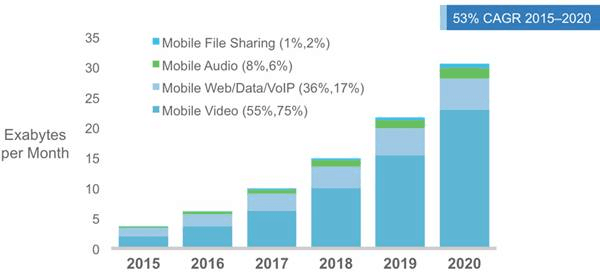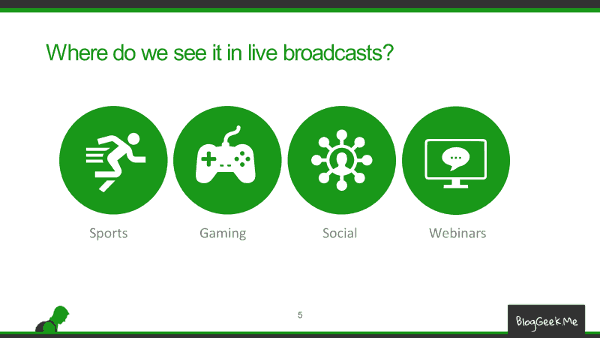The future of streaming includes WebRTC.
Disclaimer: I am an advisor for Peer5.
If you look at reports from Ericsson or Cisco what you’ll notice is the growth of video as a large portion of what we do over the Internet. As video takes up an order of magnitude more data to pass than almost anything else we share today this is no wonder. Here are a few numbers from Cisco’s forecast from Feb 2016:
- Mobile video traffic accounted for 55 percent of total mobile data traffic in 2015. Mobile video traffic now accounts for more than half of all mobile data traffic
- Three-fourths of the world’s mobile data traffic will be video by 2020. Mobile video will increase 11-fold between 2015 and 2020, accounting for 75 percent of total mobile data traffic by the end of the forecast period

Source: Cisco
I think there are a few reasons for this growth:
- While we’re continuously moving towards HD video resolutions, 4K is already being experimented with. The increase in resolution and frame rates is inevitable. We’ve seen this growth with the displays of our devices and with the cameras we hold in our pockets. Time to see it in the videos we play back
- The hegemony of content creators is broken. User generated content is growing rapidly. It started with YouTube, moving to services such as Vine and now live streaming services such as Periscope, Facebook Live, YouNow and others. More creators = more video sources
- Viewing habits are changing. We are no longer interested in TV series broadcasted on air but rather pick and choose what we want to watch and when we want to watch, from an exponentially larger pool and variety of content
The challenge really begins when you look at the Internet technologies available to stream these massive amounts of content:
- Flash / RTMP. This is how we streamed video over our internet for years, and that period is coming to an end. Google announced limiting its support to Flash by requiring users to opt in on sites that make use of it. This is causing large content sites to scurry towards HTML5 based streaming technologies
- HLS. HTTP Live Streaming – Apple’s mechanism used on iOS devices. And one that is enforced if you wish to stream to iOS devices. To some extent, this makes it “necessary” to support it elsewhere – so there’s also an HLS player for browsers
- MPEG-DASH – the standardized cousin of HLS
- Something else, not necessarily intended for video streaming
The challenge with HLS and MPEG-DASH is latency. While this might be suitable for many use cases, there are those who require low latency live streaming:

For those who can use HLS and MPEG-DASH, there’s this nagging issue of needing to use CDNs and pay for expensive bandwidth costs (when you stream that amount of video, everything becomes expensive).
Which brings me to the recent deal between Peer5 and Dailymotion. To bring you up to speed:
- Dailymotion is huge
- Similarweb ranked them #4 in their category, after YouTube, Netflix and niconico
- Their site states they have 300 million unique monthly visitors and they stream 3.5 billion videos a month
- Peer5 is a startup dealing with peer assisted delivery
- They offload video traffic and reduce strain on servers and CDNs by sending video data across peers
- They do this by using WebRTC’s data channel
- Some of the traffic of Dailymotion now flows via Peer5’s technology, and that’s now official
There are other startups with similar technologies to Peer5, but this is the first time any of them has publicized a customer win, and with such a high profile to top it off.
In a way, this validates the technology as well as the need for new mechanisms to assist in our current state of video streaming – especially in large scales.
WebRTC seem to fit nicely in here, and in more than one way only. I am seeing more cases where companies use WebRTC either as a complementary technology or even as the main broadcast technology they use for their service.
It is also the reason I’ve added this important topic to my upcoming course – Advanced WebRTC Architecture. There is a lesson dedicated to low latency live broadcasting, where I explain the various technologies and how WebRTC can be brought into the mix in several different combinations.
If you would like to learn more about WebRTC and see how to best fit it into your scenario – this course is definitely for you. It starts October 24, so enroll now.

I am very much in favor of mobile connections being used for uploading more data to peers. But then, even though my opinions are my own, I work for a telco. I am not sure if users will have the same view on this matter.
Fippo – thanks.
I am not sure where/how/when does P2P kicks in.
Here in Israel, a lot of the data bundles are considered unlimited, so it is a non-issue. Other times, you will be consuming content while at home, over a WiFi connection from a mobile device.
There are different ways in which this can be resolved, and different ways to use WebRTC (with or without data upload) in streaming scenarios 🙂